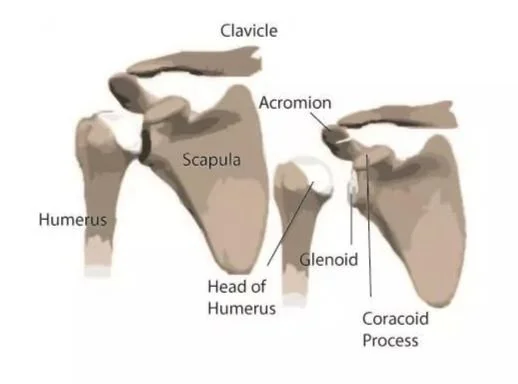Dropping Knowledge: Shoulder Anatomy
In our last post, we talked about what the Rotator Cuff is and what it does. Today, we're going on a whirlwind tour of the anatomy of your shoulder. It's not just an attachment point for strappy summer dresses, but a marvel of biological engineering.
Your shoulder is the junction where three bones (and your rib cage) rendezvous – the clavicle (collarbone), the scapula (shoulder blade), and the humerus (upper arm bone). It's like a three-way bone conference held just beneath your skin! This meeting point between your scapula and humerus form the glenohumeral joint, which, thanks to its 'ball-and-socket' design, is the maestro behind your arm's amazing range of motion. Want to reach the top shelf? Wave at your neighbor across the street? Bust out some super sick dance moves? You can thank your glenohumeral joint for all these feats.
Now, this bone bonanza would be absolute chaos without the intricate network of muscles and tendons that hold it all together. That's where our old friends from the 'Rotator Cuff Club' (the infraspinatus, supraspinatus, teres minor, and subscapularis) come in, keeping everything running smoothly and in sync. Think of them as the backstage crew at a rock concert - not always in the spotlight, but without them, the show couldn't go on.
But it's not just the rotator cuff that's deserving of applause. We also have the deltoid muscle - the showoff of the shoulder world. This muscle's large, curvy shape is what gives your shoulder its rounded appearance. Not only does it look good in a tank top, but it's also a heavy lifter when it comes to moving your arm, especially when you raise it to the side or front.
Let's do a quick roll call of our star cast:
Clavicle (Collarbone): The strut that connects your shoulder blade to your sternum and keeps you from looking like a limp noodle.
Scapula (Shoulder Blade): This flat bone acts as a base camp for your shoulder muscles and provides a surface for muscle attachment and a moving pivot point to keep thing in place as you reach up high.
Humerus (Upper Arm Bone): The long bone in your upper arm that forms a ball-and-socket joint with the scapula.
Glenohumeral Joint: The 'ball-and-socket' joint that gives your arm its superstar range of motion.
Infraspinatus, Supraspinatus, Teres Minor, Subscapularis (The Rotator Cuff Club): These are the behind-the-scenes workers who keep your shoulder stable and moving smoothly.
Deltoid Muscle: The shoulder's showoff, providing the arm with power and range of motion, as well as making your shoulders look great in sleeveless outfits.
It’s important to make sure all parts of your shoulder are working in harmony, whether you're reaching for the stars or just the Captain Crunch on the top shelf. After all, life is a performance, and your body deserves to be in the spotlight. So keep those shoulders moving!


